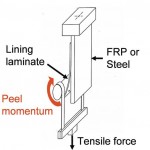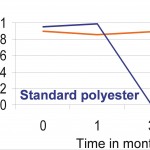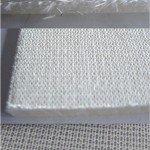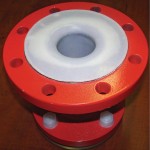Bonded fluoropolymer linings for protection against corrosion require a sufficiently strong bond between the fluoropolymer and the mechanically load-bearing structure (FRP or steel). With sheet-shaped lining laminates, this is achieved using textile fabrics (fabric backings), which are embedded into the side of the fluoropolymers away from the media. Here, the fabrics can become drenched by resins and adhesives. Fabric backings are therefore pivotal for the performance of fluoropolymer linings.
Ductile thermoforming behaviour is extremely important for the processability of lining laminates (semi-finished products consisting of fluoropolymer and fabric backing). In addition, the fabrics need to have a pronounced three-dimensional structure in order to achieve good embedding into the fluoropolymers as well as into resins and adhesives. For this reason, simple, non-stretchable fabrics have nowadays been replaced by stretchable, three-dimensional knitted fabrics for lining materials of high quality.
Assessment of bond strengths
Since shear stresses particularly challenge the junction between the lining laminate and the inner walls of the equipment, Quadrant EPP tests its lining laminates extensively using the climbing drum peel test (ASTM D 1781 standard) rather than the tensile test (simple tensile test with pulling force perpendicular to the laminate plane). The climbing drum peel test (Figure 1) often reveals big quality differences between the lining laminates, which would remain undetected by the tensile test.
All Symalit products from Quadrant fulfil the ASME RTP-1 standard (minimum bond strength: 50 inch pounds/inch at room temperature, climbing drum peel test according to ASTM D 1781). This is particularly crucial at high temperatures, where resins and adhesives are more stressed while the fluoropolymers become softer.
Glass or synthetic
In the case of PVDF and ECTFE, a choice is often available between glass and several synthetic materials. Polyester easily hydrolyses under the influence of water, and therefore is not used for fabric backings by Quadrant EPP (Figure 2).
High-quality glass knitted fabrics are a very good technical alternative. For bonded steel linings, however, they necessitate considerable quantities of relatively expensive adhesives because they have comparatively large meshes. With FRP dual laminate, they require the painstaking removal of the glass fabric along with the future welding seams, which is time consuming and hence costly.
As an alternative to the Symalit GGS glass knitted fabric, Quadrant EPP offers Symalit GK synthetic knitted fabric backing for PVDF and ECTFE products. Due to the carefully selected fibre type, the latter is resistant to almost all chemical media, including hydrochloric and hydrofluoric acid (Figure 3).
The unique fabric structure additionally provides high formability as well as bond strengths on a par with high-quality glass knitted fabric backings, even at high temperatures (within the basic range of PVDF and ECTFE applications). The finer mesh compared to glass fabric backings furthermore reduces the adhesive uptake for bonded steel linings by approximately 30 to 40 %. If FRP dual laminates are used, Symalit GK semi-finished products can help cut costs, as only long, protruding fibres have to be removed together with the future weld seams.
Cutting-edge applications
When the focus is on high-temperature applications involving concentrated hydrochloric and hydrofluoric acid, fully fluorinated lining laminates from Quadrant EPP with a glass knitted fabric backing and up to 3.8 mm fibre-free polymer thickness enable the permeation of aggressive molecules to be effectively minimised.
A knitted fabric backing with practically universal chemical resistance is a further product recently developed by Quadrant EPP. The high processing temperatures for fully fluorinated polymers like PFA limit the choice of materials here. For example, early experiments using carbon fibre fabrics ultimately failed. Due to the nature of the fibre itself, the carbon fibre fabrics could only offer low bond strengths and low thermoformability.
Instead, the company uses a PTFE knitted fabric backing for its Symalit PFA 1000 Ultra lining laminate (Figure 4). This prod-uct has a finer mesh than knitted glass fabric backings but still offers very good bond strengths, even at high temperatures, owing to its special structure. The FRP dual laminate bond strengths measured for this material in a climbing drum peel test exceed those of Symalit FEP 1000 GGS, even at 160 °C; the latter has been employed for many years in high-temperature applications. Particularly in combination with ECR glass or carbon fibre reinforcement (instead of GRP), tanks and other equipment can be built at an affordable price and expected to run for long periods under even the harshest conditions.
Online-Info www.cpp-net.com/2210402
Share:










